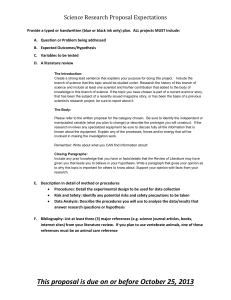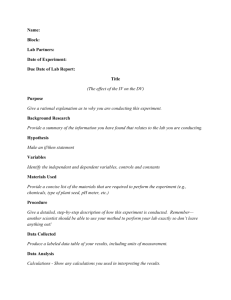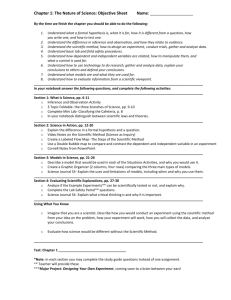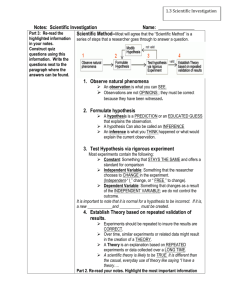Test 1 Review
advertisement
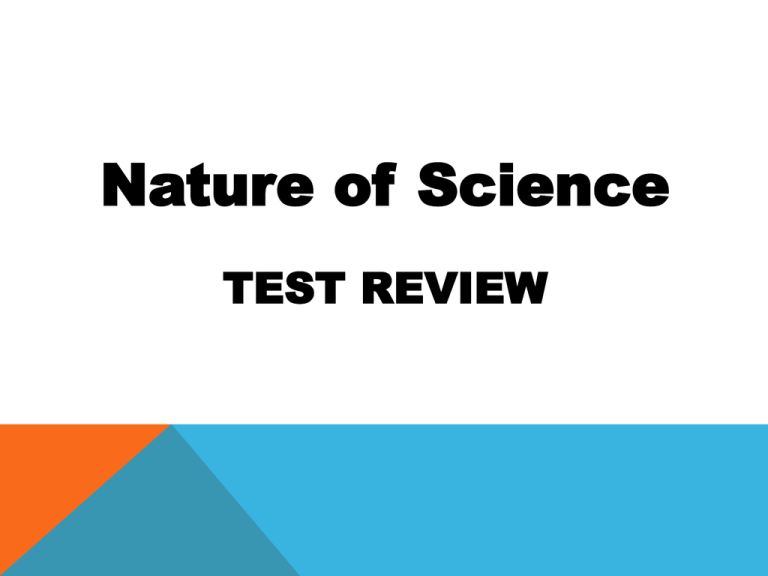
Nature of Science TEST REVIEW A factor you observe or measure during an experiment is a. Independent variable b. Dependent variable c. Variable A factor you observe or measure during an experiment is a. Independent variable b. Dependent variable c. Variable An interpretation of observations a.Explanation b.Description An interpretation of observations a. Explanation b. Description Using your senses to gather information a. Inference b. Observation Using your senses to gather information a. Inference b. Observation Factor in an experiment that do not change a. Variable b. Control Factor in an experiment that do not change a. Variable b. Control Rule that describes a repeatable pattern in nature a.Scientific Law b.Scientific Theory Rule that describes a repeatable pattern in nature a.Scientific Law b.Scientific Theory Explanation of observations or events that is based on knowledge gained from many observations and investigations a. Scientific Law b. Scientific Theory Explanation of observations or events that is based on knowledge gained from many observations and investigations a. Scientific Law b. Scientific Theory Used to study how the change in the independent variable changes the dependent variable a.Experimental Group b.Control Group Used to study how the change in the independent variable changes the dependent variable a.Experimental Group b.Control Group Spoken or written summary of observations a. Explanation b. Description Spoken or written summary of observations a. Explanation b. Description Displays very small or very large values in short form a. International System of Units (SI) b. Scientific Notations Displays very small or very large values in short form a. International System of Units (SI) b. Scientific Notations Internationally accepted system of measurement a. Scientific Notation b. International System of Units (SI) Internationally accepted system of measurement a. Scientific Notation b. International System of Units (SI) The investigation and exploration of natural events and of the new information that results from those investigations a. Scientific Method b. Science The investigation and exploration of natural events and of the new information that results from those investigations a. Scientific Method b. Science Factor that you want to test in an experiment a. Dependent variable b. Independent Variable c. Variable Factor that you want to test in an experiment a. Dependent variable b. Independent Variable c. Variable Any factor that can have more than one value a. Variable b. Dependent Variable c. Independent Variable Any factor that can have more than one value a. Variable b. Dependent Variable c. Independent Variable A statement of what will happen next in a sequence of events a. Prediction b. Hypothesis A statement of what will happen next in a sequence of events a. Prediction b. Hypothesis Possible explanation for an observation that can be tested by scientific investigation a. Prediction b. Hypothesis Possible explanation for an observation that can be tested by scientific investigation a. Prediction b. Hypothesis Logical explanation of an observation that is drawn from prior knowledge or experience a. Inference b. Observation Logical explanation of an observation that is drawn from prior knowledge or experience a. Inference b. Observation Contains same factors as experimental group, but independent variable is not changed a.Control Group b.Sample Group c.Constant Group Contains same factors as experimental group, but independent variable is not changed a.Control Group b.Sample Group c.Constant Group Formula for VOLUME a. M b. LxWxH V Formula for VOLUME a. M b. LxWxH V Formula for DENSITY a. M b. LxWxH V Formula for DENSITY a. M b. LxWxH V Which is NOT a way to test a hypothesis? a. Analyze results c. make a model b. design an experiment d. gather and evaluate evidence Which is NOT a way to test a hypothesis? a. Analyze results c. make a model b. design an experiment d. gather and evaluate evidence Which tool would a scientist use to find the mass of a small steel rod? a. Balance b. computer c. hot plate d. thermometer Which tool would a scientist use to find the mass of a small steel rod? a. Balance b. computer c. hot plate d. thermometer Which type of glassware would you use to measure the volume of a liquid? a. Beaker c. graduated cylinder b. Flask d. test tube Which type of glassware would you use to measure the volume of a liquid? a. Beaker c. graduated cylinder b. Flask d. test tube Which is NOT true of a scientific law? a. It can be modified or rejected b. It states that an event will occur c. It explains why an event will occur d. It is based on repeated observations Which is NOT true of a scientific law? a. It can be modified or rejected b. It states that an event will occur c. It explains why an event will occur d. It is based on repeated observations Constants are necessary in controlled experiments because, without constants, you would not know which variable affected the a. Control group c. dependent variable b. Experimental group d. independent variable Constants are necessary in controlled experiments because, without constants, you would not know which variable affected the a. Control group c. dependent variable b. Experimental group d. independent variable While analyzing the results from an investigation, a scientist calculates a very small number that he or she wants to make easier to use. Which does the scientist use to record the numbers? a. Explanation b. inference c. scientific notation d. scientific theory While analyzing the results from an investigation, a scientist calculates a very small number that he or she wants to make easier to use. Which does the scientist use to record the numbers? a. Explanation b. inference c. scientific notation d. scientific theory Which is NOT an SI base unit? a. Kilogram b. liter c. liter d. second Which is NOT an SI base unit? a. Kilogram b. liter c. liter d. second SCIENTIFIC SCENARIO Hypothesis Independent Variable Dependent Variable Constant 2 cm 4 cm 6 cm What is the Volume of the rectangle? If the Mass is 28 g, what’s the Density of the rectangle? METRIC LADDER KILO HECTO DECA Base Unit DECI CENTI MILLI Underline the root word (base unit) for the following: KILOGRAM Underline the Prefix for the following: KILOGRAM Write the symbols for the following: KILOGRAM METRIC CONVERSIONS 100 mm = ____________ cm 100 cm = _____________ m 1,000 m = _____________ km

